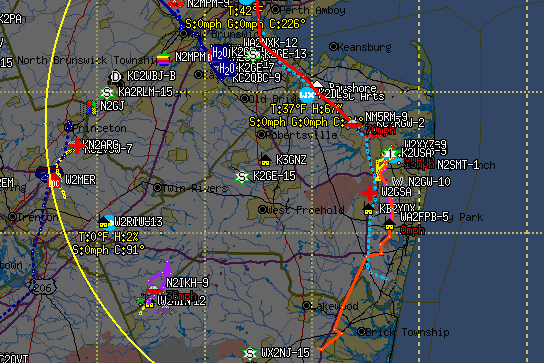FETs blow up and other things I've learned

Well my IF tap worked great for a few hours and after I shut down my rig….signals were not right. I learned what seems to be a fundamental lesson about JFETs…they don’t like static much. I’m 99% sure that I zapped the JFETs in the buffer amp I installed after doing some reading on how static sensitive they are. At least my rig is just fine otherwise.
So I got an alternative design buffer amp that’s sitting here waiting for me to pop the hood again and install it. This one doesn’t use JFETs, so my gorilla paws without a static mat won’t be as likely to cook it.
In other news, I’ve rewired myself again for packet radio and APRS operations. Using Xastir on Ubuntu linux, I’ve had APRS up and running a few days consecutively here and there. Pretty neat stuff and can be very handy for any mass deployment events.
In a nutshell, APRS takes GPS coordinates or other information and sends it out as a beacon via radio. So if I’m running the mapping and client software and you are in the field with a handheld running APRS, I can see your position as it is beaconed every few minutes overlaid on a map.
If you are providing event support over an entire marathon course as an example, as the control operator or other field station, at a glance you would be able to see the location of all your operators. This becomes important when you get a call that a runner or rider has been injured and needs first-aid. The closest support vehicle can be instantly located. Not only that, but you can follow that vehicle on the map and know when it arrives at the hospital or control point.
You can beacon most any data up to a limit of 40 characters per beacon. Commonly people beacon their position and then a frequency they are listening to. This way when you see them up close, if you see them you know how to reach them. It can be fun while traveling around just to make contacts as you ‘run into’ them.
Generally this is all done on the 2m ham band for local coverage. But even with that system, there are facilities to repeat or ‘digipeat’ the traffic a station hears. So if I beacon, a station within range will hear it, and then transmit again. Yet another station further out will pick that up and repeat it again, and so on. Add that it is also possible to send the data out to the internet from home stations and you can reach pretty much anyone on the network, world wide.
There are even low frequency links that will broadcast the traffic hundreds or thousands of miles in a single hop. This can all be incredibly useful in the even of a major disaster that knocks out telecommunications services. Hams have the ability to set up field stations with these capabilities in a matter of hours. It’s something not often remembered about this ‘hobby’ as witnessed here ARRL article about the Haiti earthquake
blog comments powered by Disqus